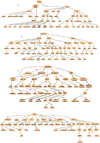Tumor suppressor maspin as a rheostat in HDAC regulation to achieve the fine-tuning of epithelial homeostasis
- PMID: 23140166
- PMCID: PMC3612174
- DOI: 10.1615/critreveukargeneexpr.v22.i3.80
Tumor suppressor maspin as a rheostat in HDAC regulation to achieve the fine-tuning of epithelial homeostasis
Abstract
Maspin, a class II tumor suppressor, is often downregulated during tumor progression and its depletion from the nucleus is associated with poor prognosis. Recently, we reported that reintroduction of maspin is sufficient for redifferentiation of prostate cancer cells to epithelial phenotype, a reversal of epithelial-to-mesenchymal transition. We have linked this effect of maspin with its ability to directly inhibit HDAC1, thereby influencing the acetylation state of transcription factors and other proteins. Maspin overexpression leads to changes in the expression level of a large number of proteins and these changes are often microenvironment specific. In this review, we summarize the epigenetic effects of maspin and provide comprehensive bioinformatic analysis of microarray-derived gene expression changes caused by maspin in different microenvironments. The analysis was performed on multiple levels, including identification of statistically enriched gene ontology groups, detection of overreprepresented transcription factors binding sites in promoters of differentially expressed genes, followed by searching for key nodes of regulatory networks controlling these transcription factors. The results are consistent with our hypothesis that maspin serves as an endogenous regulator of HDAC activity and suggest that the effect of maspin is primarily mediated by TGFβ, β-catenin/E-cadherin pathways, and network key nodes such as Abl kinase, p62, IL1, and caspases 6 and 8.
Figures



Similar articles
-
HDAC1 inhibition by maspin abrogates epigenetic silencing of glutathione S-transferase pi in prostate carcinoma cells.Mol Cancer Res. 2011 Jun;9(6):733-45. doi: 10.1158/1541-7786.MCR-10-0505. Epub 2011 May 26. Mol Cancer Res. 2011. PMID: 21622623 Free PMC article.
-
Snail transcription factor negatively regulates maspin tumor suppressor in human prostate cancer cells.BMC Cancer. 2012 Aug 2;12:336. doi: 10.1186/1471-2407-12-336. BMC Cancer. 2012. PMID: 22857708 Free PMC article.
-
Endogenous inhibition of histone deacetylase 1 by tumor-suppressive maspin.Cancer Res. 2006 Sep 15;66(18):9323-9. doi: 10.1158/0008-5472.CAN-06-1578. Cancer Res. 2006. PMID: 16982778
-
Tumor suppressive maspin and epithelial homeostasis.J Cell Biochem. 2006 Mar 1;97(4):651-60. doi: 10.1002/jcb.20721. J Cell Biochem. 2006. PMID: 16329135 Review.
-
A role of novel serpin maspin in tumor progression: the divergence revealed through efforts to converge.J Cell Physiol. 2006 Dec;209(3):631-5. doi: 10.1002/jcp.20786. J Cell Physiol. 2006. PMID: 17001674 Review.
Cited by
-
Identification of an intrinsic determinant critical for maspin subcellular localization and function.PLoS One. 2013 Nov 21;8(11):e74502. doi: 10.1371/journal.pone.0074502. eCollection 2013. PLoS One. 2013. PMID: 24278104 Free PMC article.
-
Expression patterns of maspin and mutant p53 are associated with the development of gestational trophoblastic neoplasia.Oncol Lett. 2016 Nov;12(5):3135-3142. doi: 10.3892/ol.2016.5074. Epub 2016 Sep 1. Oncol Lett. 2016. PMID: 27899973 Free PMC article.
-
Integrating the tumor-suppressive activity of Maspin with p53 in retuning the epithelial homeostasis: A working hypothesis and applicable prospects.Front Oncol. 2022 Nov 29;12:1037794. doi: 10.3389/fonc.2022.1037794. eCollection 2022. Front Oncol. 2022. PMID: 36523976 Free PMC article. Review.
-
Maspin is a PTEN-Upregulated and p53-Upregulated Tumor Suppressor Gene and Acts as an HDAC1 Inhibitor in Human Bladder Cancer.Cancers (Basel). 2019 Dec 18;12(1):10. doi: 10.3390/cancers12010010. Cancers (Basel). 2019. PMID: 31861435 Free PMC article.
-
The vulnerable primed cancer stem cells in disguise: demystifying the role of Maspin.Cancer Metastasis Rev. 2022 Dec;41(4):965-974. doi: 10.1007/s10555-022-10070-2. Epub 2022 Dec 1. Cancer Metastasis Rev. 2022. PMID: 36451067 Free PMC article. Review.
References
-
- MacDougall R. Bert Vogelstein considers the cancer genome at 10th annual NHGRI Trent Lectureship. National Human Genome Research Institute DIR News Features [Internet] 2012 Available from: http://www.genome.gov/27547785.
-
- Polyak K, Weinberg RA. Transitions between epithelial and mesenchymal states: acquisition of malignant and stem cell traits. Nat Rev Cancer. 2009;9(4):265–273. Epub 2009/03/06. - PubMed
-
- Jiang N, Meng Y, Zhang S, Mensah-Osman E, Sheng S. Maspin sensitizes breast carcinoma cells to induced apoptosis. Oncogene. 2002;21(26):4089–4098. Epub 2002/05/31. - PubMed
-
- Ben Shachar B, Feldstein O, Hacohen D, Ginsberg D. The tumor suppressor maspin mediates E2F1-induced sensitivity of cancer cells to chemotherapy. Mol Cancer Res. 2010;8(3):363–372. Epub 2010/03/04. - PubMed
Publication types
MeSH terms
Substances
Grants and funding
LinkOut - more resources
Full Text Sources
Other Literature Sources
Miscellaneous

